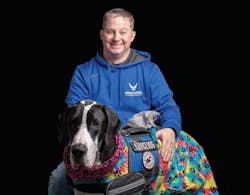Disabilities in the medical laboratory workplace
Laboratory supervisors and their staff members are asked to wear many hats. Working in the blood bank, for example, may have you performing type and crossmatches one day, training new technicians on blood issue policies the next, and preparing your department to implement new lab equipment on the floor the day after that—and in many situations this is all in the same day.
Staff members with disabilities
One of the less common (but just as important) challenges faced by laboratory supervisors is staff members with disabilities. Disabilities present themselves in many forms including mental and physical. Disabilities can make certain aspects of the job challenging not only for the employee, but for a supervisor to position the employee to succeed. Federal law, as well as laboratory accreditation standards, address some of these issues. An advantage we have as laboratory professionals is that in many situations a simple adjustment to the employee’s role can help staff with disabilities perform well, while continuing to meet both law and laboratory guidelines and requirements.
The law
The United States Congress passed the Americans with Disabilities Act (ADA) in 19901 to address discrimination in the workplace with oversight given to the Equal Employment Opportunity Commission (EEOC). The act states that a disabled person is identified as “physical or mental impairment that substantially limits one or more major life activities.”2 This may include difficulty walking, standing for long periods of time, difficulty in reading laboratory documentation due to dyslexia, or, for example, difficulty drawing blood due to excessive hand shaking. In addition, the law does not allow an employer to treat an applicant or employee less favorably than a healthy employee due to disability. The law goes on to state that employers are required to make reasonable accommodations to an otherwise qualified person.1 Reasonable accommodations include possible wheelchair access or modifications to normal practice(s) in the workplace. However, the term “reasonable accommodations” can be subjective.As a supervisor you may ask how far of an accommodation is required to meet the letter of the law. First, an employer is not required to make accommodations that result in undue hardship(s). For example, a technician broke their ankle at home and is unable to climb stairs as a result. As a supervisor, you are not required to move the laboratory instrumentation to the first floor to accommodate the staff member. However, you can direct him/her to the building elevators to accommodate their limited mobility and/or adjust their work assignments to enable the person to work at a desk instead of standing during recovery. The disabled employee should be able to perform the essential tasks of their position. Discrimination based on a disability regarding hiring, firing, pay, work assignments, promotions, layoffs, and training is forbidden under the law.3 This accommodation is also applicable to laboratory accreditation checklist items.
Ergonomic plan
The College of American Pathologists (CAP) general checklist contains both Phase I and II items that are relevant to disabled employees. Environmental Safety (GEN.77200) addresses ergonomic situations in the laboratory in regard to disabilities. This checklist generally covers work-related hazards in the laboratory via the facility’s ergonomic plan. The plan should include steps to address disabled personnel. For obvious reasons, a plan can’t be written that covers all possible disabilities, however, addressing and accommodating staff disabilities is important.
Another common scenario is a disabled staff member experiencing low back and/or knee pain. Typically, implementation of the laboratory ergonomic plan addresses this issue. For example, if a staff member cannot stand on their feet all day, a chair can be provided, or the member can be assigned tasks that enable sitting, such as quality control review, or workload management.
Color blindness
Working in a medical laboratory presents dozens of tasks that require the ability to not only distinguish color but differentiate between colors. Some examples include reading hematology slides, processing microbiology culture samples, and/or measuring color changes in point-of-care tests. As such, color discrimination (GEN.55400) is a standard checklist item that addresses visual color discrimination (color blindness) in laboratory employees.
The ADA states an employer cannot discriminate against an applicant or employee due to color blindness. Also, evaluation of an employee is not required if the employee works in a role that doesn’t require color discrimination such as administration or documentation management. To work with members with color blindness, a supervisor could delegate the disabled employee to load (identical color blood tube) samples onto an analyzer, or work in the blood bank or urinalysis department.
Evacuation plan
General checklist (GEN.73900) reflects the facility’s evacuation plan. If your laboratory employs disabled personnel the evacuation plan, “must cover all personnel, patients and visitors, and must address the special needs of persons with disabilities.”4 There are additional checklist items that impact disabled personnel; however, the examples given are the most applicable to the ADA and disabled personnel.
How to accommodate staff members with disabilities depends on the flexibility of the position and a realistic accommodation of the situation. For example, if a staff member is bedridden due to a medical disability, there may be no reasonable accommodations that can be made. (I doubt that sending blood slides to the member’s house to review while in bed would not prevent undue hardship to the lab staff!) Therefore, it is the flexibility to meet the needs of the laboratory as well as the staff member’s disability—which is the key to success in this situation.
Wheelchairs
An employee that is either confined to a wheelchair or ends up in one due to an injury presents a challenge to all laboratories. Space is at a premium in any area considered “support” to the medical mission. If the wheelchair bound employee works in a section of the laboratory such as hematology or microbiology, they could be assigned, for example, to read blood slides or micro culture plates from a desk. The lab can also generate a work position or fill a vacant position that utilizes the skill sets of the person while meeting the needs of their disability. Suggested roles could include quality assurance, administration (for an experienced staff member), and/or reception to the phlebotomy room, or entry to the laboratory department.
A disabled laboratorian may also be matched to a service dog in order to meet the work position they are assigned to. From a personal perspective, I was diagnosed with stage 4 melanoma in March of 2013. I underwent nine surgeries including four brain surgeries. As a result, I developed a severe balance and dizziness issue. This makes moving around very difficult under normal circumstances. Matching to a service dog through the Service Dog Project has enabled me to perform more actively in the laboratory community, including traveling to conferences.
A valid question that gets raised from time to time is whether or not a service dog can be utilized by a hospital employee. As you can imagine, there are multiple challenges to the introduction of a service dog to the laboratory workplace. These include (but are not limited to) cultural sensitivities, trip hazards, phobias, allergies, and exposure to zoonoses.4
Guidelines from the ADA indicate that any non-sterile location (such as intensive care unit or operating room) can be entered by a service dog.1 A disabled lab technician that requires mobility assistance from a service animal could fill a number of important roles, including a bench technician to read hematology slides, teaching medical laboratory students, performing compatibility matching, and/or any number of regular laboratory testing. Again, if you fit the disabled staff to the right task(s), they will excel; a continual challenge that every lab manager faces with both disabled and non-disabled employees.
The Service Dog Project
The Service Dog Project (SDP) has donated over 150 Great Dane service dogs to mobility impaired individuals to assist them in achieving greater independence. Their working service dogs have been placed with veterans and individuals with Multiple Sclerosis, Parkinson’s Disease, Cerebral Palsy, etc. Each dog receives extensive training for balance and mobility.5
Why Great Danes? Balance support dogs should be at least 45 percent of the person’s height and 65 percent of their weight. This means a 6-foot tall man would need a 30” dog in order to put stability at the person’s fingertips. Great Danes are well suited to home and office life. Also, their perfect public persona makes them very conducive to help with the isolation and depression which often accompanies disabilities.5
Conclusion
The implementation of the ADA has challenged medical laboratories to productively utilize their disabled laboratorians. This utilization includes meeting accreditation checklist items and ensuring effectiveness of the laboratory staff. Work-arounds discussed for disabled laboratory staff are not comprehensive by any means. If you ask any ten laboratory supervisors, I would bet that each of them could present unique disability challenges faced by their lab during their tenure. Laboratory managers and supervisors must come up with creative solutions that help both the disabled staff member(s) and the laboratory mission as a whole, creating a win-win situation for all parties involved.
REFERENCES
- Eeoc.gov. (2019). The Americans With Disabilities Act of 1990. [online] https://www.eeoc.gov/eeoc/history/35th/1990s/ada.html [Accessed 25 Feb. 2019]. Facts About the Americans with Disabilities Act https://www.eeoc.gov/eeoc/publications/fs-ada.cfm
- Eeoc.gov. (2019). Disability Discrimination. [online] https://www.eeoc.gov/laws/types/disability.cfm [Accessed 25 Feb. 2019].
- Laboratory General Checklist. College of American Pathologists. Aug 2017.
- Foreman A, Glenn M. et al. Dogs in the Workplace: A Review of the Benefits and Potential Challenges. International Journal of Environmental Research and Public Health. 2017 May 8; 14(5): 498.
- Servicedogproject. (2019). Mobility Disabled | United States | Service Dog Project. [online] Available at: https://www.servicedogproject.org/ [Accessed 4 Mar. 2019].
About the Author

Lt Col Paul R. Eden, MT(ASCP), PhD, USAF (retired)
has 24 years of laboratory experience managing both clinics and hospital laboratories including over six of years of applied research. He is also serving as Adjunct Assistant Professor, Pharmacology & Toxicology, Wright State University, Ohio.

